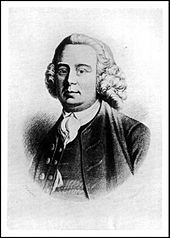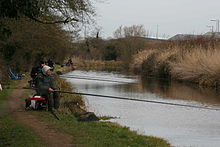Oxford Canal


The Oxford Canal is a 124 km (77 miles) long canal in England and runs from Oxford via Banbury and Rugby to Coventry . It connects the Thames at Oxford with the Coventry Canal and the Grand Union Canal . The canal's first connection with the river was made in 1789 with the Duke's Cut and the Wolvercote Mill Stream , the second connection was made in 1796 via the Sheepwash Channel , Castle Mill Stream and Isis Lock . The Oxford Canal runs largely through Oxfordshire , Northamptonshire and Warwickshire and is one of the most scenic canals in England.
In the 18th century it was a main artery for trade between the English Midlands and London . Today it is mainly used by recreational and houseboats, the narrowboats .
history
The Oxford Canal was built in several stages over a period of around 20 years.
The British Parliament passed the relevant law to build the Oxford Canal in 1769. The main objective was to connect the industrial area around Birmingham with the Thames and thus with the British capital.
Construction work
The construction work was initially led by the English engineer and canal builder James Brindley . When he died in 1773, his assistant Samuel Simcock took over the management. In 1774, when construction progressed to Napton, the originally approved budget was exhausted and the project had to be suspended for a short time.

In 1775, further funds were approved for the construction of the canal and construction work resumed. In 1778 the canal reached Banbury . The completion of the last section to Oxford could not begin until 1786 due to renewed financing problems.
On this last stretch from Banbury to Oxford, extensive cost-cutting measures were implemented. These measures included the use of cheaper building materials (e.g. wood instead of brick) and the inclusion of existing waterways (e.g. the River Cherwell near Oxford).
The last section to Oxford was officially opened on January 1, 1790. For a short time the Oxford Canal was one of the most important and profitable routes in England, on which the Oxford Canal Company handled most of the trade between London and the Midlands. Mainly coal, stone and agricultural products were transported. With the commissioning of the canal, the price of coal in Oxford fell to one eighth within a very short time.
A more direct route between London and the Midlands, the Grand Union Canal , was completed in 1805 and resulted in commercial traffic on the Oxford Canal decreasing significantly from that point on.
Competition railroad
After 1820 there was increasing competition from the beginning of the railway construction. In 1823 the first plans to build a railway line between Birmingham and London were developed. Originally the connection was also supposed to lead via Oxford to London, but the railway company under Robert Stephenson decided in 1830 for an alternative route via Coventry , not least because of feared flooding problems through the Thames near Oxford. In 1838 the connection was officially put into operation. With falling steel prices and advancing technology, rail transport became more and more attractive. The length of the rail network in England multiplied from 742 miles in 1838 to 5127 in 1848. The Railways Conveyance of Mails Act of 1838 stipulated that the railroad had to carry the correspondence of the Royal Mail. More powerful locomotives and immense investments in infrastructure ultimately led to a large part of the goods traffic being diverted from the canals to the rails.
The Oxford Canal today
Narrowboat
Today the Oxford Canal is used almost exclusively by pleasure boats and canal boats, the so-called narrowboats . A total of around 48,000 boats are permitted on the English waterways (2004). Narrowboats usually have a width of 2.08 m and a length of up to 22 m and are now powered by diesel engines.
The following picture shows how a narrowboat drives through a lock.
fishing
Especially in the early morning and evening hours, when the traffic on the canal subsides, there are numerous anglers. With the improving water quality, perch , chub and carp can be caught today. Licenses are issued by the operator of the canal ( Canal & River Trust ).
Biking and hiking trails
The Oxford Canal is still lined with well-preserved towpaths . These paths directly on the river bank used to be used as work routes for workers and draft animals, especially horses. Today the towpaths are used intensively by hikers and cyclists, even though the paths are difficult to pass, especially after prolonged rainfall and in winter. Hikers appreciate the Oxford Canal Walk as a well-signposted walking route covering a total of 133 km from Oxford to Coventry.
Web links
- The Inland Waterways Association (English)
- Cycle paths along the Oxford Canal (English)
- Well-illustrated section of the trail Oxford Canal Walk (English)

